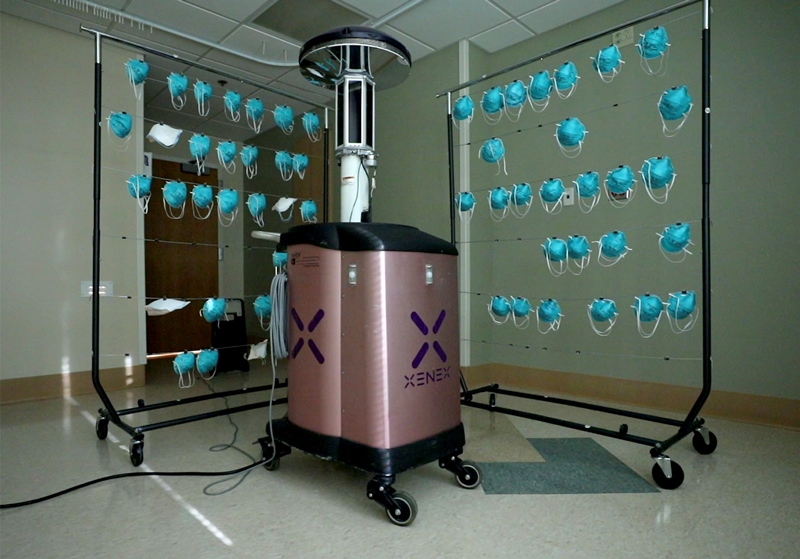In an effort to conserve personal protective equipment (PPE) for healthcare workers amid the nationwide shortage and supply chain disruption caused by COVID-19, Riverside Health System in Virginia has begun cleaning and reprocessing N95 respirators, infection prevention leadership announced this week.
Officially speaking, the N95 respirators are systematically cleaned with an ultraviolet germicidal irradiation machine located at Riverside Regional Medical Center.
The team at Riverside Regional Medical Center, where two of these machines are located, calls the robotic device “Annie.”
That’s largely because Annie does look like a robot, and it does put out UV light to decontaminate items in a room, said Tiffany Beatley, RN, an infection preventionist at Riverside Regional Medical Center.
It’s a process that’s long been used at Riverside Regional Medical Center, Beatley said.
In today’s environment, though, “the corporate leadership team, in anticipation of the shortage that the nation is experiencing of N95s and our limited supply going forward, looked at the different methods to reprocess disposable PPE out there,” said Christi Archer, RN, MBA, MSN, Riverside’s System Director for Infection Prevention.
“There have been several methods that you see floating around on the internet, but through my research, the UV machine was the only one that actually had evidence to support it and that would not only decontaminate the respirator, but the respirator would also maintain its filtration and protection levels,” Archer said.
Riverside, following a proven process developed and tested by the University of Nebraska, implemented the reprocessing of N95s this week, starting first with Riverside Regional Medical Center.
Later this week, N95s from Riverside Walter Reed Hospital in Gloucester will be brought to Riverside Regional Medical Center, and then soon the program will encompass all of the health system’s hospitals, ambulatory care centers and lifelong health facilities.
 The process the infection prevention team developed, Archer said, starts with health care workers labeling their N95 respirators. After use, the N95 is placed in a paper bag, which is also labeled. Paper bags from each hospital unit, and other hospitals, are then placed into a bin and couriered to Riverside Regional Medical Center for reprocessing. Following reprocessing, the N95s go back to the same units and health care workers.
The process the infection prevention team developed, Archer said, starts with health care workers labeling their N95 respirators. After use, the N95 is placed in a paper bag, which is also labeled. Paper bags from each hospital unit, and other hospitals, are then placed into a bin and couriered to Riverside Regional Medical Center for reprocessing. Following reprocessing, the N95s go back to the same units and health care workers.
There are parameters around which N95s can be reprocessed. For example, one that has lost its seal, been soiled with make-up or is not a good fit would not be reprocessed.
“Theoretically we can double our usage by recycling the N95s up to three times,” Archer said. “We’ve also been in conversations with materials scientists at NASA and had discussions about how they might help us extend the life of an N95 respirator even further.”
This reprocessing effort, Archer said, is just one piece of a larger PPE conservation plan the health system rolled out when COVID-19 “started really getting everyone’s attention and we started seeing our supply lines change. We implemented immediately a PPE conservation plan and got way ahead of this thing. Now this gives us another way to continue looking at how we can extend our supply.”



